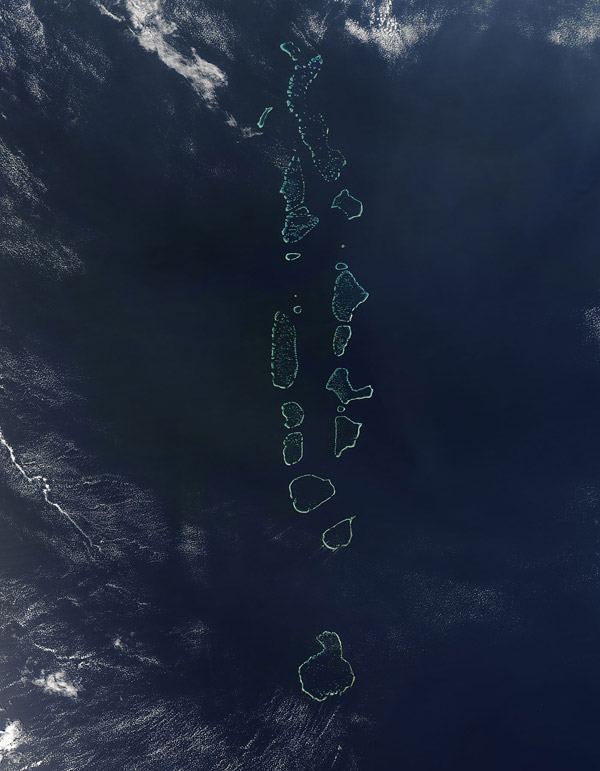Images
February 13, 2017 - Maldive Islands, Indian Ocean
Tweet
On February 7, 2017, NASA’s Aqua satellite flew over the Indian Ocean southwest of India, allowing the Moderate Resolution Imaging Spectroradiometer (MODIS) aboard to capture a true-color image of the jewel-toned sparkle of the Maldive Islands.
The Maldive Islands are a group of coral islands resting atop an ancient volcanic mountain range. The theory of atoll formation states that the volcanic mountaintops (islands) give coral polyps a foundation upon which to fasten upon. Once fastened to the foundation, the coral reef begins to grow upward and sometimes outward. As the volcano becomes dormant (or as sea level rises) the top of the volcano begins to subside, eventually dropping below water level. Eventually, all that is left is the coral atoll.
The Maldives are made up of a cluster of 22 atolls grouped in an elongated formation that stretches about 511 miles (823 km) from north to south. Each of the atolls is made up of several dozen reefs. On some of the reefs, rubble, sediment, and bits of dead coral have piled up enough to form low, flat islands. About 350,000 people reside on those islands.
Image Facts
Satellite:
Aqua
Date Acquired: 2/7/2017
Resolutions:
1km (81.4 KB), 500m (320.2 KB), 250m (802.3 KB)
Bands Used: 1,4,3
Image Credit:
Jeff Schmaltz, MODIS Land Rapid Response Team, NASA GSFC
Tweet
On February 7, 2017, NASA’s Aqua satellite flew over the Indian Ocean southwest of India, allowing the Moderate Resolution Imaging Spectroradiometer (MODIS) aboard to capture a true-color image of the jewel-toned sparkle of the Maldive Islands.
The Maldive Islands are a group of coral islands resting atop an ancient volcanic mountain range. The theory of atoll formation states that the volcanic mountaintops (islands) give coral polyps a foundation upon which to fasten upon. Once fastened to the foundation, the coral reef begins to grow upward and sometimes outward. As the volcano becomes dormant (or as sea level rises) the top of the volcano begins to subside, eventually dropping below water level. Eventually, all that is left is the coral atoll.
The Maldives are made up of a cluster of 22 atolls grouped in an elongated formation that stretches about 511 miles (823 km) from north to south. Each of the atolls is made up of several dozen reefs. On some of the reefs, rubble, sediment, and bits of dead coral have piled up enough to form low, flat islands. About 350,000 people reside on those islands.
Image Facts
Satellite:
Aqua
Date Acquired: 2/7/2017
Resolutions:
1km (81.4 KB), 500m (320.2 KB), 250m (802.3 KB)
Bands Used: 1,4,3
Image Credit:
Jeff Schmaltz, MODIS Land Rapid Response Team, NASA GSFC




